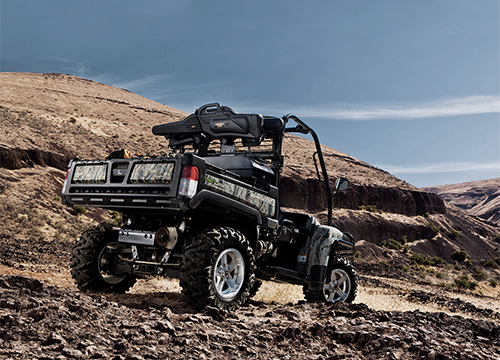Having the right vehicle for the job can make all the difference. The John Deere Gator 825i is the perfect multipurpose piece of machinery
The latest addition to the John Deere line-up in South Africa is the 825i. Part of the Gator range of utility vehicles, it’s an all-new crossover utility vehicle (XUV) that’s able to work all week and play all weekend. With a 37 kW, 812 cc three-cylinder engine, it utilises electronic fuel injection to provide superior throttle response and instant starting, not to mention low exhaust emissions.
The versatile 825i combines a 4×4 drivetrain and trail-tuned suspension with exceptional cargo capacity: it can handle a payload of 635 kg and pull a 680 kg trailer. Meanwhile, the engine’s excellent low-end torque makes it ideal for towing, and for climbing hills. Given its head, it’ll hit 71 km/h.
Double-wishbone suspension (there’s 20 cm of travel at the front and 23 cm at the rear) ensures that all four wheels stay on the ground, and working for you. With its wide stance, long wheelbase and low centre of gravity, the body of the 825i stays level and stable, almost irrespective of terrain. This also translates into best-in-class ride quality, with both the crew and cargo guaranteed to stay in place.
Talking of cargo, bulky goods can be conveniently secured to the steel-reinforced load area with 20 tie-down points, while a bakkie-style tailgate makes for easy loading and unloading. And, so that you can plug in a host of accessories, the vehicle is fitted with a beefy 75 amp alternator, capable of generating one kilowatt of power.
When the going gets really tough, a press of a switch provides on-demand four-wheel drive for the toughest trails, while the rear differential can be locked so that the wheels push together through tricky spots. And the CVT transmission takes care of all the shifting, so the only decision you’ll be required to make is when to use low-range and when to engage four-wheel drive.
The 825i is engineered to tackle the rough stuff day in and day out, thanks to heavy-duty components. Steel skid plates protect the underbody, while a hydroformed frame offers exceptional tolerance for twisting under heavy loads.
So, is the new 825i XUV more a recreational toy than a hard-working tool? The good news for drivers who work hard and play hard is that the highly capable crossover vehicle fulfils both roles with aplomb.
What’s a Gator?
In a sentence: it’s the most versatile, durable, efficient and safe utility vehicle in the world. This reputation has been earned over more than two decades, with the Gator range continuing to evolve to meet the changing needs of consumers across the planet.
Whether you want to go farming or fishing, there’s a model to suit you, with an array of features that can be tweaked to your specific requirements. A range of factory-installed options and dealer-available add-ons make this the perfect multipurpose tool for the 21st century. Two-wheel-drive, four-wheel-drive, petrol, diesel… There’s definitely a hardworking Gator for you and your business.
John Deere: past, present, future
For 177 years, John Deere has dedicated itself to those who are linked to the land: farmers, landowners and builders. The company has never outgrown, or forgotten, its founder’s original core values of integrity, quality, commitment and innovation. But these are more than ideals, they are values that John Deere people around the world live and breathe, and they can be found in every product and service.
The brand’s activities in South Africa started 51 years ago and originally included manufacturing implements and assembling tractors from a Nigel-based factory. Then, in 2005, there was a change of direction: manufacturing ceased and the focus moved to sales and marketing, with all products imported from a choice of 100 manufacturing plants worldwide.
More recently, John Deere South Africa assumed responsibility for sub-Saharan Africa and the growth potential and expansion offered by this new market.
For more information, visit www.deere.co.za.
Photography John Deere
(This article was first published in the winter 2014 issue of AA traveller magazine)





